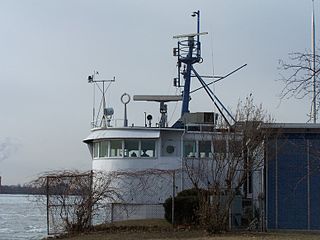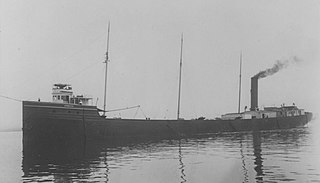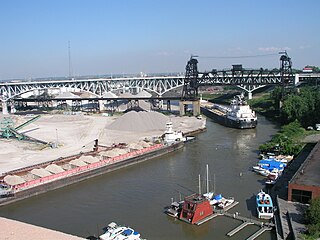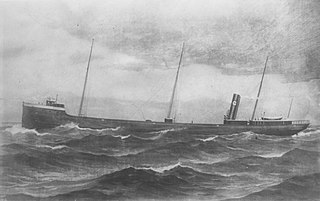
Newport News Shipbuilding (NNS), a division of Huntington Ingalls Industries, is the sole designer, builder, and refueler of aircraft carriers and one of two providers of submarines for the United States Navy. Founded as the Chesapeake Dry Dock and Construction Co. in 1886, Newport News Shipbuilding has built more than 800 ships, including both naval and commercial ships. Located in the city of Newport News, Virginia, its facilities span more than 550 acres (2.2 km2).

A steamship, often referred to as a steamer, is a type of steam-powered vessel, typically ocean-faring and seaworthy, that is propelled by one or more steam engines that typically move (turn) propellers or paddlewheels. The first steamships came into practical usage during the early 1800s; however, there were exceptions that came before. Steamships usually use the prefix designations of "PS" for paddle steamer or "SS" for screw steamer. As paddle steamers became less common, "SS" is incorrectly assumed by many to stand for "steamship". Ships powered by internal combustion engines use a prefix such as "MV" for motor vessel, so it is not correct to use "SS" for most modern vessels.

A bulk carrier or bulker is a merchant ship specially designed to transport unpackaged bulk cargo—such as grain, coal, ore, steel coils, and cement—in its cargo holds. Since the first specialized bulk carrier was built in 1852, economic forces have led to increased size and sophistication of these ships. Today's bulk carriers are specially designed to maximize capacity, safety, efficiency, and durability.

Lake freighters, or lakers, are bulk carrier vessels operating on the Great Lakes of North America. These vessels are traditionally called boats, although classified as ships. Freighters typically have a long, narrow hull, a raised pilothouse, and the engine located at the rear of the ship.

SS William Clay Ford was a bulk freighter built for hauling material on the Great Lakes. She was named for William Clay Ford Sr., grandson of Henry Ford. Her keel was laid in 1952 at River Rouge, Michigan by the Great Lakes Engineering Works, and she was launched in 1953. The ship was a part of the Ford Motor Company fleet of ore carriers and made her home port at Ford's River Rouge Plant, south of Detroit, Michigan. The first captain of William Clay Ford was John Jameson Pearce of Dearborn, Michigan.
The Defoe Shipbuilding Company was a small ship builder established in 1905 in Bay City, Michigan, United States. It ceased to operate in 1976 after failing to renew its contracts with the United States Navy. The site of the former company is now being developed for business and housing on the bank of the Saginaw River.

An inboard motor is a marine propulsion system for boats. As opposed to an outboard motor where an engine is mounted outside the hull of the craft, an inboard motor is an engine enclosed within the hull of the boat, usually connected to a propulsion screw by a driveshaft.

Marine propulsion is the mechanism or system used to generate thrust to move a watercraft through water. While paddles and sails are still used on some smaller boats, most modern ships are propelled by mechanical systems consisting of an electric motor or internal combustion engine driving a propeller, or less frequently, in pump-jets, an impeller. Marine engineering is the discipline concerned with the engineering design process of marine propulsion systems.

SS Appomattox was a wooden-hulled, American Great Lakes freighter that ran aground on Lake Michigan, off Atwater Beach off the coast of Shorewood, Wisconsin in Milwaukee County, Wisconsin, United States in 1905. On January 20, 2005 the remnants of the Appomattox were listed on the National Register of Historic Places.

The SS St. Marys Challenger is a freight-carrying vessel operating on the North American Great Lakes built in 1906. Originally an ore boat, she spent most of her career as a cement carrier when much larger ore boats became common. After a 107-year-long working career as a self-propelled boat, she was converted into a barge and paired with the tug Prentiss Brown as an articulated tug-barge. Before conversion, she was the oldest operating self-propelled lake freighter on the Great Lakes, as well as being one of the last freight-carrying vessels on the Great Lakes to be powered by steam engines.

Algoma Buffalo, formerly Buffalo, is a diesel-powered lake freighter acquired by Algoma Central Corporation in 2018. This vessel was built in 1978 by Bay Shipbuilding Company at their yard in Sturgeon Bay, Wisconsin for the American Steamship Company and included self-unloading technology. The ship is 634 feet 10 inches (193.50 m) long and 68 feet (21 m) wide, with a carrying capacity of 24,457 tons deadweight (DWT), and is primarily used to ship road salt and construction goods. The vessel is currently in service.

W.H. Gilcher was a steam lake freighter built in 1890–1891 by Cleveland Shipbuilding Company of Cleveland for Gilchrist, Gilcher & Schuck of Sandusky, with intention of transporting cargo between various ports located on the Great Lakes. The ship was named after William H. Gilcher, one of the owners of the company. In October 1892 the freighter ran into a strong gale on Lake Michigan and foundered with the loss of eighteen men.

The Frank C. Ball was an American Bulk carrier that was built by the Great Lakes Engineering Works of Ecorse, Michigan, for the Globe Steamship Company of Duluth, Minnesota. She was launched on December 9, 1905, as hull #14. She was powered by a 1,700 horsepower triple expansion steam engine and fueled by two coal-fired Scotch marine boilers. Even though Ball was built in 1905, she only entered service in 1906.

The William H. Donner was an American Great Lakes freighter that was built in 1914 by the Great Lakes Engineering Works of Ashtabula, Ohio for service on the Great Lakes of North America. She was used to transport bulk cargoes such as iron ore, coal, grain and occasionally limestone. She operated from 1914 as a bulk carrier to 1970 when she was converted to a floating crane ship with two cranes. In order to facilitate better maintenance most of the ship's superstructure was eventually removed. It remained in service until 2016, when it was deemed obsolete to requirements. In 2020, the vessel, which consisted of only the hull and minus the cranes, was finally sold for scrap. It was towed on December 17 from Marinette Wisconsin to the Purvis Scrap Yard in Soo, Ontario Canada above the Soo Locks. The dismantling process will begin sometime in early 2021.

SS Senator was a steel-hulled Great Lakes freighter that sank on Lake Michigan with the loss of nine lives and 268 Nash automobiles, on Halloween of 1929 after she was rammed in heavy fog by the bulk carrier Marquette. She lies in 450 feet (140 m) of water 16 miles northeast of Port Washington, Wisconsin. On April 12, 2016 her wreck was listed on the National Register of Historic Places.

The MV Kaye E. Barker is a self-discharging lake freighter owned and operated by the Interlake Steamship Company. She was originally built as the Edward B. Greene, and was later renamed Benson Ford before being sold to Interlake and named the Barker. It primarily hauls hematite pellets, stone, and coal across the North American Great Lakes.
The River class is a type of bulk carrier designed for service on the Great Lakes. The MV Mark W. Barker, the first of the class is due to enter service for the Interlake Steamship Company on 27 July 2022.

SS John Mitchell was a steel-hulled, American lake freighter in service between 1907 and 1911. She was built in 1906 by the Great Lakes Engineering Works in St. Clair, Michigan, for the Cornell Steamship Company of Chicago, Illinois, which was managed by C.W. Elphicke. She entered service in 1907, and had a sister ship named William B. Davock. Throughout her career, John Mitchell carried iron ore and coal. On October 4, 1908, she ran aground at Indiana Harbor, Indiana, while loaded with iron ore.
Benson Ford Sr., originally named Edsel Ford Jr, was an American businessman in the automotive industry, a vice-president of Ford Motor Company, and national co-chairman of the National Conference of Christians and Jews. Benson Ford remains famous for: being the first prominent person in the Ford family to actively preach religious harmony between faiths through his NCCJ co-chairmanship ; through the internationally famous Benson Ford Research Center in Dearborn, Michigan, which bears his name; and the now historic 1924 Great Lakes freighter Benson Ford Ship named after him, now known as the Benson Ford Shiphouse, in Put-In-Bay, Ohio. Benson was also noteworthy as being the one member of the Ford family most closely associated with Lincoln-Mercury, rather than Ford, where under Benson's guidance the experimental Lincoln Futura car was developed. The Futura later became the most famous and recognizable car in the world for several years, television's Batmobile driven by Batman actor Adam West.
















